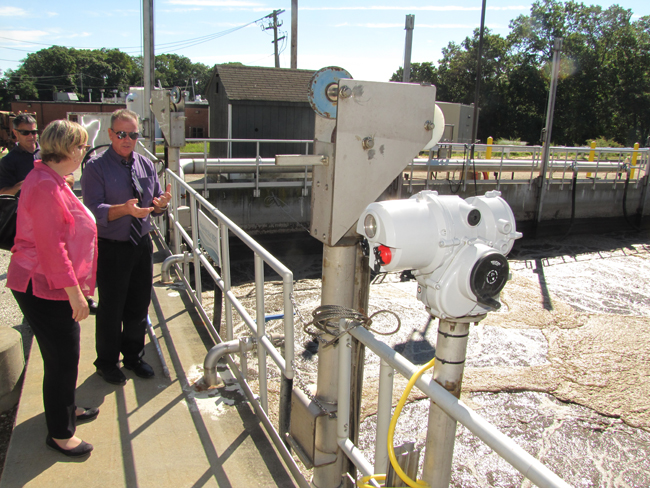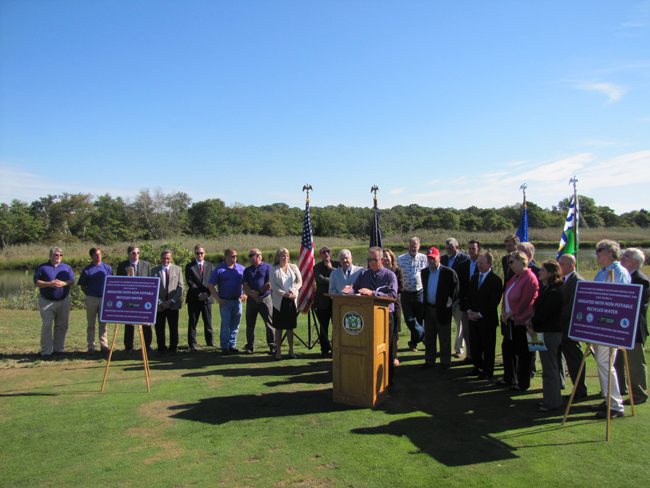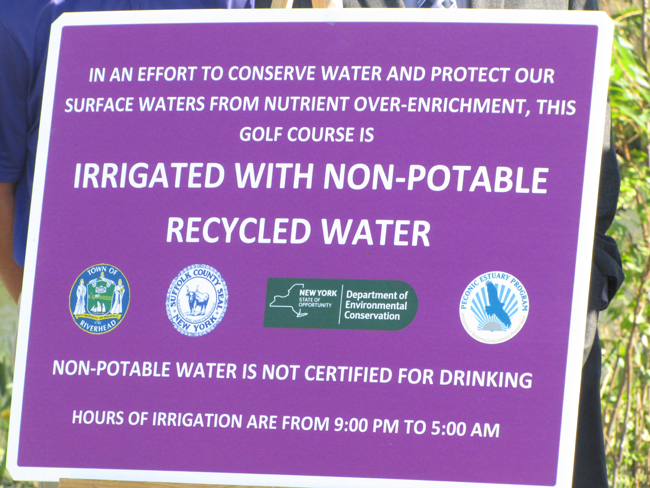Environmentalists, officials extol benefits of upgraded sewer plant


In the mid-1980s when brown tide first struck the Peconic Bay — devastating the local shellfish industry in the process — people needed a bad guy, according to Kevin McDonald of the Nature Conservancy.
For many, he said, that “bad guy” quickly became the Riverhead Town Sewage Treatment Plant, which discharged treated sewage effluent into the Peconic Bay from a pipe under the Route 105 bridge.
But with a $24 million sewage plant upgrade that removed additional nitrogen finished, and an innovative project that uses treated effluent to water the adjacent Indian Island Golf Course set to start Monday, Riverhead now is being praised in the environmental community, said Mr. McDonald, who is also the chairman of the Peconic Estuary Program’s Citizens Advisory Committee.
Environmental advocates, elected officials, sewer plant workers, county golf course workers and others gathered at a press conference Friday morning on the fifth hole at Indian Island and heaved compliment after compliment on Riverhead and its sewer plant.
The $24 million upgrade, which includes the price of the golf course irrigation project, was aided by an $8 million grant from Suffolk County, and a low-interest New York State Environmental Facilities Corporation loan.
Mr. McDonald said that while Riverhead’s sewer plant discharge accounted for about a quarter of the nitrogen in the Peconic Bay system in the 1980s, it currently accounts for only about two to three percent.
The U.S. Environmental Protection Agency last year presented Riverhead’s sewer plant superintendent Michael Reichel with its “Environmental Champion Award” for his role in the project, which was discussed as far back as the 1980s, according to EPA regional director Judith Enck, who attended Friday’s press conference.
“Nitrogen contributes to algal blooms and contamination of water resource, and it effects recreation and tourism,” Ms. Enck said. “And in a nut shell, high levels of nitrogen increase aquatic plant growth in water bodies, and too much plant growth will consume too much oxygen in the water. This is a real threat on Long Island.”

The golf course project, in which an underground main from the sewer plant is connected to the county golf course’s irrigation pump house, “is the first ever on Long Island,” according to Alison Branco, the director of the Peconic Bay Estuary program.
The “water resource recovery project,” as its being called, diverts an additional 1.4 tons of nitrogen per year from the Peconic River. Instead, it is used for off-hours irrigation on the golf course.
Up to 450,000 gallons per day of treated effluent can be used on the golf course, out of 1.2 million total, Mr. Reichel said. The remainder still is discharged in the river.
However, the amount of nitrogen discharged into the river is now much lower.
The upgrade will allow just 30 to 40 pounds of nitrogen per day to be discharged into the bay, as opposed to the prior rate of about 170 pounds per day, Mr. Reichel said.
He said the county shuts down its irrigation system around Thanksgiving.
Riverhead Supervisor Sean Walter said Mr. Reichel has been pushing for the golf course project since 2001 over the span of three supervisors.
The idea of using sewer effluent on the county golf course was actually studied by the county back in the 1980s, Mr. Reichel said, but at that time, the county decided the project wasn’t feasible.
As the plant gained the ability to remove more nitrogen, the golf course project became more realistic, officials said.
Other municipalities that have seen what Riverhead is doing with the golf course now have expressed interest in doing similar projects, officials said.
“My hope is that we reach a point where this becomes status quo,” said South Fork Assemblyman Fred Thiele (I-Sag Harbor).

Ms. Enck said going forward, issues that will be targeted in the battle against nitrogen will focus on wastewater treatment plants, residential septic systems, lawn fertilizer and storm water runoff.
In addition, she said, airborne nitrogen, caused by the burning of fossil fuels, is another big source of nitrogen that must be reduced.
Top photo caption: Riverhead sewer department head Michael Reichel gives a tour of the upgraded plant to EPA regional administrator Judith Enck Friday. (Credit: Tim Gannon)








